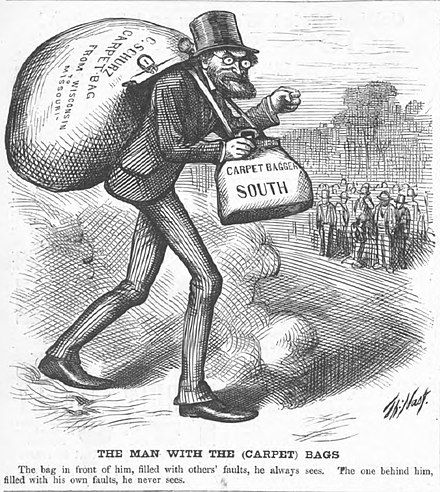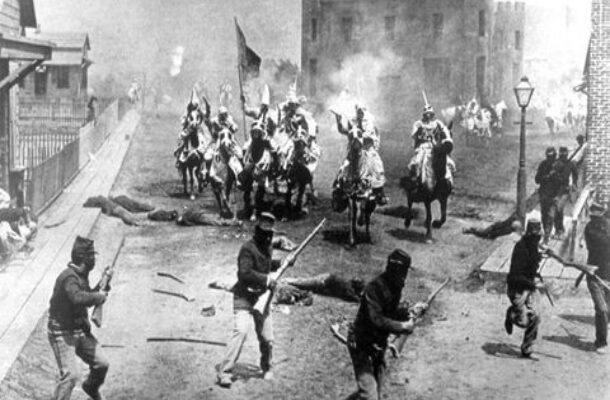I am constantly annoyed by a painfully ignorant comment I stumble upon frequently – in some form or another – which generally states, “The Democrats started the Klan,” or “The AntiFa and the Klan – both Democrats in masks.” This frustratingly stupid sentiment is nearly as annoying as comments such as, “The AntiFa are the real Fascists.” It is yet another example of the American deracination training beginning in the 1950s and the myopic ignorance of the modern American political “Right.” Correcting them is pointless. Tragically, Dinesh D’Souza is their primary source of American history. It is worse when the individual is a Southerner. This piece hopes to give context to the Ku Klux Klan, especially in light of our current cultural and political crisis, and educate those who are more intellectually curious than Sean Hannity.
The original Ku Klux Klan were heroes – full stop. The Klan of 1865-1877 formed the first resistance against an aggressively antagonistic, radical Yankee occupying force. Organized at a local level, with almost no centralized support, the original Klan was initiated by elite Southern gentlemen. These men, former officers who served the Confederacy during the War of Northern Aggression, created the Klan largely out of desperation for a people – their people – who were under assault at every level of their being. Culturally, socially, commercially, and physically, Southerners were stripped of their pride, starved, humiliated, and in many cases, subjected to sexual abuse by black troops with either the tacit approval of abolitionist officers or by direct command. Someone needed to defend the Southern people, especially Southern women, and the Ku Klux Klan was born from that need.
Before I write further, there are five truths that you, the reader, must appreciate and accept, otherwise, there is no point in reading any further. First, the Ku Klux Klan underwent several iterations, not all of which were equal. Second, Reconstruction was brutal. It was not a series of magnanimous acts of a benevolent federal government, forgiving and rebuilding the South. It was exploitative and overwhelmingly cruel.
Third, the Federal Government of the post-war era was heavily influenced by Marxists, especially 48er descendants from the Midwest and radical egalitarians from the Northeast. Their ideology played a key role in the barbarity that would be enacted upon the South. Fourth, the occupying commands of the South were largely led by men chosen for their ideological zeal for radicalism, not their military acumen. That was due to the fact that the U.S. Government prioritized Western expansion. Capable military officers were given commands designed for the future Indian Wars of the Plains and Mountains. Those chosen to manage Reconstruction were politically appointed, Marxist ideologues, imposing their will through the utilization of significant numbers of recently freed black troops. Again, this was due to White troops having been sent West in an effort to subjugate the Indians. Those ideologues were there to impose the philosophical will of a radical U.S. Government on the South. Picture degenerate AntiFa members with battalions of armed blacks now in charge of Southern towns with no governmental oversite and a disarmed and decimated local population.
Finally, fifth, the South had a right to secede and in so doing, the defeat of the South provided no moral justification for the cruelty imposed by their Yankee oppressors. This was purely a manifestation of armed Marxist revenge. The Confiscation Acts that starved the Southern people were nothing more than pure, unadulterated, cruelty.

Having now placed the era in context, the reader is better equipped to understand the original Ku Klux Klan. However, since much of that which is known about the Klan is largely the legacy of their recent iterations, it is also important that you understand the iterations and decouple them from the pathetically ill-informed history taught by men like Dennis Prager. This context is important.
There are generally four iterations of the Ku Klux Klan, with some scholarly disagreements as it pertains to the continuity of the Klan and its lineal legacy. The first iteration of the Klan was relatively short-lived, generally from 1865 -1877, with its most active phase from 1867 – 1872. That Ku Klux Klan, a Southern Nationalist resistance organization, is the primary subject of this article. The second iteration of the Klan emerged in 1915, and although Southern in origin, it was very different from the original Klan.
The second KKK was a pro-American entity versus a pro-Southern entity. In fact, to this day, the Klan is a pro-American entity that consequently does not support secession (except broadly “White”). The second was decidedly more focused on the increasing influence of immigrants, especially criminal Jewish immigrants from Eastern Europe. It was also focused on the deleterious impact of organized Northern Catholics – namely the Irish – who were undermining the United States with pro-labor union and progressive policies through the use of their political machines. The first iteration of the Klan enjoyed significant support from Southern Catholics; the second saw them as an enemy. Eventually, the second iteration would disintegrate due to internal conflicts and The Great Depression.
The third iteration of the Klan reemerged in the 1950s. It operated with greater organized capacity for violence than the second iteration, but less than the first. This was largely a reemergence focused on the so-called Civil Rights Era, in which blacks and predominantly Jewish activists sought to eliminate segregation, while the federal government imposed its will on the South (yet again). As radical black activists and the anti-war movement spread its Marxist messaging throughout the U.S., the third iteration gained strength, until a number of legal challenges from leftist groups coupled with FBI investigations decapitated the organization in the early 1980s. Some entities lingered into the early 1990s, but they never had the strength they held at their zenith between about 1960 – 1975. This is where I split from alleged experts on “hate groups” and the Klan: the fourth – or modern iteration – of the Klan.
The fourth iteration of the Klan is interesting. Most scholars lump it with the third iteration. I do not. For the most part, the modern Klan is a disparate group with a wide range of pro-White beliefs, ranging from White Separatism to Neo-Fascism. This is the result of splintering that occurred in the 1990s. Consequently, a lot depends on the group with which one is affiliated. Many entities have been heavily infiltrated by federal agents and staffed with the absolute worst examples of “white trash,” which further erodes confidence and capabilities. I have met quite a few modern Klansmen – some were very impressive, some were obvious federal agents, and some were complete clowns.
The wars in Afghanistan and Iraq, however, coupled with the Obama era and the obvious anti-White hatred spreading like wildfire throughout the world seems to have helped the modern Klan, and I believe they are entering a fifth iteration. There are about 30 primary Klan groups in the United States today with about 150 chapters, but roughly a half dozen are genuine “Invisible Empire” – utilizing meticulous recruiting, redirecting federal agents to buffoonish “Klan” entities, and remaining highly disciplined. They also seem to be coalescing into a single unit. The modern Klan has benefited from a combination of years of military experience, recruiting disabused White combat veterans coupled with recent former Civic Nationalist militia types who have awakened to racial reality. Whereas some like to dismiss the Klan, I would estimate their numbers in 2010 was probably about 5,000 nationwide and likely stands at closer to 30,000 worldwide as of 2020, with a fast-growing presence in the U.S. military thanks to its anti-White policies. It will be interesting to see where they go in the next few years, but it also stands in direct contrast to the goals of a publication such as ours: advocacy for Southern Nationalism.
It is important to reiterate that the Klan iterations from the second to the fourth are pro-American, not pro-Southern. Even the increasingly more effective modern version of the Klan seeks an American revival. This is antithetical to Southern Nationalists. While most Southern Nationalists lament that which they see occurring throughout the rapidly collapsing United States, ours is a Southern cause. Thus, the post-1915 Klan pledge cannot be recited and honored by a Southern Nationalist. However, that would not have been true of the first iteration of the Klan – men who fought valiantly against an oppressive military (and cultural) occupation of the South.
The original Klan began as a lighthearted attempt to entertain townspeople in Pulaski, Tennessee, beginning around Christmas 1865. It would soon become a Southern resistance army – an insurgency. Reiterating the brutality that marked Reconstruction, the Klan stood between ordinary Southern people recovering from the war and ideologically driven violence led by radical abolitionist officers and their vengeful uniformed black troops. Modern scholars like to dismiss this characterization of Reconstruction as a fantasy construed by the likes of novelists such as Thomas Dixon, Jr. (The Clansman) or director D.W. Griffith (The Birth of a Nation). They are wrong. We know this from historical accounts of eyewitnesses, many of whose works have since been suppressed or outright banned in the United States. Thankfully, Russia has maintained these records.
One of the most comprehensive books on the origins of the Ku Klux Klan was written by Susan Lawrence Davis, entitled, The Authentic History of the Ku Klux Klan: 1865-1877. Ms. Davis was the daughter of an early member of the Klan and a survivor of the Yankee occupation. She was present as a child during the early formation of the Klan in her area, Limestone County, Alabama. Her book, published in 1924, involves hundreds of interviews of early Klansmen, news clippings from the era, and documentary evidence of its formation, as well as pictures. Davis was the trusted daughter of Confederate Colonel Lawrence Ripley Davis, and early Klansman, gaining her access to members and archives that were denied others.
Describing its trajectory into an insurgency, she marks the moment it occurred in her area:
“The following incident is one of many which caused the Ku Klux Klan to change the ‘social club’ which was their first intention, into a protective organization. Three miles from Athens [Alabama], a Confederate soldier, Mr. Ed Tanner, who was honorably discharged… because of ill-health, was called to the door, late one night, dragged into the highway, and shot by negro soldiers, and his body was pinned to the ground by a sharpened fence rail, so the negro soldiers might ride over it…. I watched my father out of the gate-way on this bright moonlight night and saw many hundreds of the Ku Klux Klan in their white robes… on to the home where the fiendish deed had been done. The negro soldiers who had murdered Mr. Tanner, were pursued by the Ku Klux Klan to the Tennessee River… and were almost overtaken… [they tried to cross the river] by dismounting, [and] cross the railroad [bridge] by foot. They encountered an incoming train and jumped from the bridge into the river, where… several of them drowned. The murder of Mr. Tanner and other outrages by the negro soldiers was the means of strengthening the Ku Klux Klan…”
The Authentic History of the Ku Klux Klan: 1865-1877, 1924, Page 41-43
This is just one of many examples highlighted by Ms. Davis regarding outrageous behavior by recently freed blacks. In addition, radical White females from the North further pushed Southerners into the arms of the Klan:
“Suffrage had been denied the men of the seceding states by the Government at Washington, so legislative power to control this [White women who had been sent from the North to teach the negroes and began dating them] was not possible. The negro men were enfranchised and the state officers were filled with them and carpet-baggers… The condition rankled in the hearts of the proud Southerners… it was therefore natural that they should turn to the source of relief… the Ku Klux Klan…” (Pg. 36)
The Authentic History of the Ku Klux Klan: 1865-1877, 1924, Page 36
Many of the Yankee White women were “sexually liberated” in the 19th Century. They were greatly influenced by the works of Christian-Socialist “Pastors,” such as John Humphrey Noyes, who opened a community of “sexually free” Christians in the mid-19th Century. This led to Yankee White women having sexual relations with black males whom they were sent to educate. Problems began shortly thereafter when freed black men assumed all White women were the same way and began forcing themselves upon Southern White women who neither had an interest in black men nor an interest in premarital sex (both shameful in Southern society at the time). When overtures were rejected, black men frequently raped Southern White women, often out of anger. When White Southerners sought justice through radical Yankee and black-led courts, the courts dismissed their claims. Again, the Ku Klux Klan became the answer for Southerners seeking justice.
Davis goes on to describe that much of the anti-White Southern violence was inspired by White men. Yankees excoriated Southerners from newspapers and Congregationalist pulpits, both in the North and from vantage points as carpet-baggers in the South. In many cases, they advocated the complete genocide of Southerners, all of which led able-bodied Southern men to join the ranks of “The Invisible Empire” in greater numbers. In one case, Henry Ward Beecher, the brother of the prominent author of Uncle Tom’s Cabin, Harriet Beecher Stowe, sought to impose starvation as a means to force miscegenation and breed out Southern Whites: “The negro is superior to the white race. If the later do not forget their pride of race and color, and amalgamate with the purer and richer blood of the blacks… [Southern Whites] will die out and wither away in unprolific skinniness.” (Pg. 123)
In 1875, from the same pulpit of Beecher’s church, abolitionist Wendell Phillips, stated to applause within the Yankee church: “I know it means something like barbarian conquest… but I do not believe there will be any peace until 347,000 men of the South (CSA veterans) are either hanged or exiled.” (Pg. 123) As the radical anti-Southern Republican administrators were sent to the South, they exacted such wishes upon the Southern people, confiscating food, property, and dignity. The Ku Klux Klan fought back.

Contrary to revisionist history, the Ku Klux Klan remained active until Reconstruction and Nathan Bedford Forrest led it throughout Reconstruction. I believe, in part, this is due to official government reports that attempted to make it seem as though the Ku Klux Klan Act of 1871 was working. Rather, the Klan became far more localized and strengthened its grip throughout the South. For his part, Forrest made it seem as though he disbanded the organization in 1869, but Davis reports eyewitness testimony from meetings in which Forrest personally directed the Klan through 1876, when Reconstruction was finally withdrawn. The fact that modern historians do not know this element of Klan history is highlighted in their retelling of the Hamburg Riots (aka, the Hamburg Massacre) and a group called “The Red Shirts.”
The Hamburg Riots were the direct result of radical, anti-White Republicans in South Carolina hoping to suppress the White vote by creating an 8,000 member black militia, armed with the newest weapons from Springfield, Massachusetts. Under the leadership of a black man named Doc Adams, they paraded in front of White Southern towns. Eventually, two White men riding a cart came upon the black militia in the streets of their hometown and, while attempting to pass, they were threatened, before being allowed to pass. After this, the local Klan gathered together, led by future Senator, Benjamin Tillman. On July 4th, 1876, the Klan assaulted the menacing militia and routed them. The militia, which greatly outnumbered the Klan by nearly 80-to-1, lacked the military skills of the former Confederate troops who were members of the Klan. Surrounded, the blacks eventually ran out of ammunition and attempted to escape – most of whom did. However, a few of the leaders were hunted down by the Klan and some were executed for the crime of threatening the White townsfolks of South Carolina. When Yankee newspapers “waved the bloody shirt” (i.e., called for military action, Pg. 185), Tillman responded with a “Red Shirt Parade” – effectively daring the Yankees to come fight, again. Contrary to historians who like to claim the Red Shirts as something of an offshoot that was organized before the noble deeds at Hamburg, South Carolina, the term “Red Shirt” was coined after the courageous acts of local Southern men. It was a direct response to Klan solidarity. Meanwhile, realizing they could not beat the pride out of the Dixian, Marxist Republicans eventually relented – ending Reconstruction a year later, when Southerners reclaimed some part of their political future. The Klan did that.
Stories such as these and many more – in which Southern Whites were terrorized by Yankee Republicans and their vengeful black counterparts – are the very reason for the formation of the original Klan. These men were heroes. Were they Democrats? Hardly. They may have eventually voted Democrat, but they were Southern patriots, first and foremost. Back then, the policies of limited government and states’ rights were Democratic Party positions, not Republican ones.
Before I conclude, it is important to note one other facet of the origins of the original Ku Klux Klan. Captain John B. Kennedy (CSA) sought to use the term “Kukloi,” from the Greek “Kuklos” (circle) in the formation of a fraternity of Southern officers. Fraternities throughout the South frequently used the term. Major James Crowe (CSA) recommended “Ku Klux,” similar, but with the intention of hiding the actual origins of the term from non-members. It was then Captain John Lester (CSA), who added the term “Klan” in honor of their Scots-Irish roots. This means something.
Whereas I cannot speak for the modern Klan, it is important to note that the original Klan was a fraternity of men, dedicated to the South and their Scots-Irish heritage. These men were heroes. Without the original Ku Klux Klan, Dixie would have suffered more depredations at the hands of radical Republican Yankees and freed blacks. These defenders of their people not only ensured justice when it was denied to the Southern people, they instilled order where radical Yankees sought to exploit chaos. They contributed greatly to an earlier end to Reconstruction.
When no one would stand-up for the South, the Ku Klux Klan did. The first Klan, born out of the Confederacy’s defeat, the depredations of their people during Reconstruction, and eventual liberators of the South, should be honored for this task – whether they were Democrats or not.
The son of a recent Irish immigrant and another with roots to Virginia since 1670. I love both my Irish and Southern Nations with a passion. Florida will always be my country. Dissident support here: Padraig Martin is Dixie on the Rocks (buymeacoffee.com)






Jefferson Davis, Robert E. Lee, John C. Breckinridge, George Corley Wallace and Strom Thurmond were all originally and primarily Southern Democrats. Look at the Presidential Election Map of 1924. The Solid South was Democrat. White Supremacy for the Right
Excellent!
Outstanding piece, Sir!! I have always enjoyed your work. However, I do have some commentary to make:
“Contrary to revisionist history, the Ku Klux Klan remained active until Reconstruction and Nathan Bedford Forrest led it throughout Reconstruction. I believe, in part, this is due to official government reports that attempted to make it seem as though the Ku Klux Klan Act of 1871 was working. Rather, the Klan became far more localized and strengthened its grip throughout the South. For his part, Forrest made it seem as though he disbanded the organization in 1869, but Davis reports eyewitness testimony from meetings in which Forrest personally directed the Klan through 1876, when Reconstruction was finally withdrawn.” I do own the book you pulled this from and have admittedly not yet read it, but in not a single work of the entire Dunning School’s repertoire is this claim made not is the evidence given to back it up. I am not saying I disagree with you, but I have not yet seen the evidence. I suppose I will have to read Ms. Davis’ account.
Outstanding piece, Sir!! I have always enjoyed your work. However, I do have some commentary to make:
“Contrary to revisionist history, the Ku Klux Klan remained active until Reconstruction and Nathan Bedford Forrest led it throughout Reconstruction. I believe, in part, this is due to official government reports that attempted to make it seem as though the Ku Klux Klan Act of 1871 was working. Rather, the Klan became far more localized and strengthened its grip throughout the South. For his part, Forrest made it seem as though he disbanded the organization in 1869, but Davis reports eyewitness testimony from meetings in which Forrest personally directed the Klan through 1876, when Reconstruction was finally withdrawn.” I do own the book you pulled this from and have admittedly nor yet read it, but in not a single work of the entire Dunning School’s repertoire is this claim made not is the evidence given to back it up. I am not saying I disagree with you, but I have not yet seen the evidence. I suppose I will have to read Ms. Davis’ account.
Thank you for those kind words, Sir. I am a fan of your writing, as well, and i intend to follow this note by sharing a link to your many great articles on Reconstruction.
Regarding that which Davis reports as it pertains to Nathan Bedford Forrest, it was interesting and surprising to me, too. It appears he is still very much involved well into 1877, at which time he then believes the Klan had served its purpose. What appears to have occurred after the 1871 Klan Act was that the Klan went deeper underground and consolidated its power. Another interesting tactic that I am seeing replicated today: Southern patriots identified federal agents seeking to infiltrate the Klan and therefore, created Klan units that were specifically designed to funnel feds into that Klan unit. One outfit in TN was almost entirely comprised of Pinkertons who did not realize they were all working for the Feds.
Again, thank you for the compliment and I hope you enjoy reading Ms. Davis’ book.
God Bless,
Padraig Martin
If anyone else who reads this is interested to know more about the horrors of Reconstruction, you will find that information here: https://identitydixie.com/tag/reconstruction/ .
I am reading the powerful accounts in the linked articles. I would love to see you guys publish the book on the Reconstruction and the Rape of the South after the Civil war.
As an avid history reader, I am still hesitant to read anything regarding the history of the South, the same way I am postponing the reading the painful history of my former country.
A little bit off topic:
Reading comments over the years, on social media, by Northerners, I get the impression that many, albeit mostly subconsciously, fear Southern revenge. I’ve seen a few who express fears that it will be with nuclear weapons, in Southern hands. Or by a foreign power, showing sympathy for Dixie, that attacks the Northern United States, while leaving the South, and the West, largely untouched.
I think that this is what partly drives their current obsession with what the Russians are up to.
A sidenote to a sidenote:
Many Northerners seem unnaturally interested in the political processes of, and
the elections in, our Southern States. Even to the point that many of them are unaware of the political processes in their own States. Or as to the characters and natures of their own governors and state legislators.
They’re definitely guilt ridden and fearful. Something for Southern Nationalists to consider. For good or I’ll.